How did ABC get away with a show where heroes and villains actually — gasp! — fight? Here’s how…
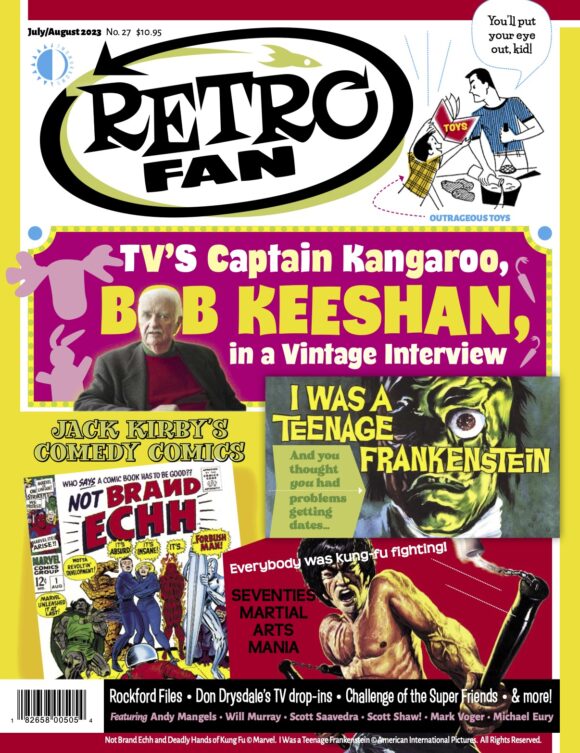
The latest RetroFan — Issue #27 — includes the usual assortment of awesome and for our EXCLUSIVE EXCERPT, we pick up where we left off last time, with Andy Mangels’ ongoing history of Super Friends.
The latest installment focuses on the show’s third season, whose hour-long episodes featured fairly typical half-hour segments, followed by 30-minute adventures that are probably the series’ most popular — Challenge of the Superfriends, co-starring the Legion of Doom.
But how did Hanna-Barbera pull that off, given ABC’s desire to stay away from violence and outright conflict? Read on — but first check out the table of contents:
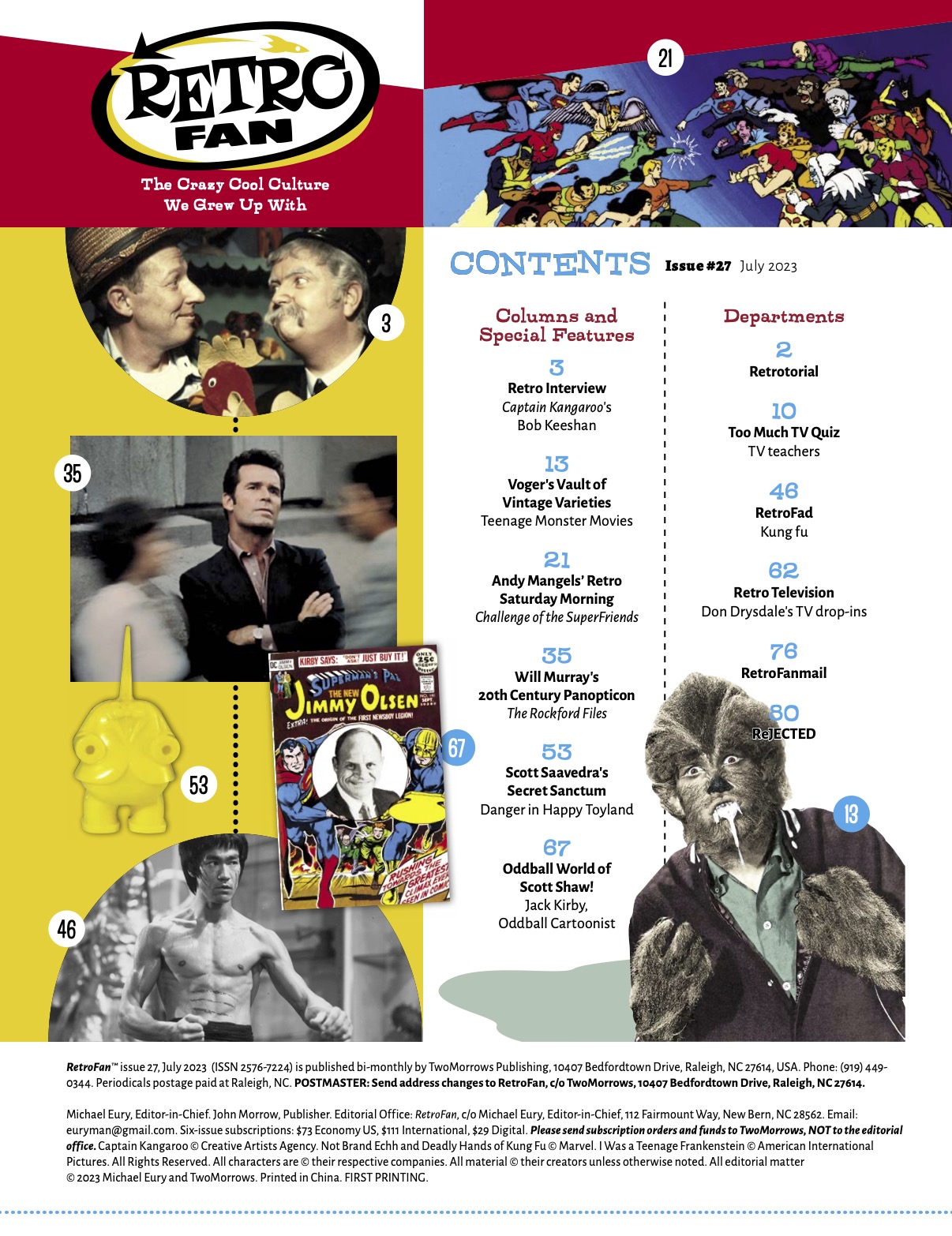
Scott Saavedra’s history of dangerous toys is a must-read!
—
By ANDY MANGELS
ABC’s Challenge of the SuperFriends was designed to be radically different than other entries of the show. The subtitle was, for a brief time, “Battle of the SuperHeroes,” but everyone knew that opening word would never make it past ABC’s Standards & Practices.
Gone for this incarnation were the Wonder Twins, and the group was now called the Justice League more often. Members included Flash, Green Lantern, Hawkman, Black Vulcan (gone too were his pants!), Apache Chief, and Samurai, but while Hanna-Barbera had diversified its cast by featuring the minority heroes more regularly, it short-shrifted its female viewers, now offering them Wonder Woman as the token female.
Fighting against the heroes was the Legion of Doom, whose headquarters in a swamp, the Hall of Doom, blatantly resembled Darth Vader’s helmet from the year-old theatrical megahit Star Wars.
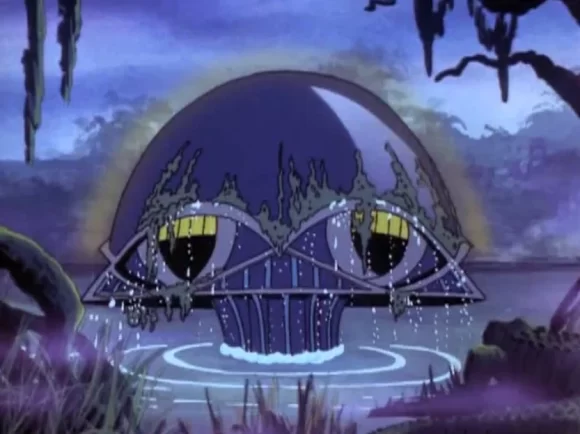
The 13 well-known comic-book villains included Lex Luthor, Brainiac, Cheetah, the Riddler, the Scarecrow, Toyman, Sinestro, Black Manta, Captain Cold, Bizarro, Gorilla Grodd, Solomon Grundy, and Giganta. For those keeping count, that was two females, and no villains of color… unless one counted magenta or lime-green aliens (the African-American Black Manta never unmasked). But the villains’ line-up was not always the same 13 bad guys.
Alex Toth was the legendary lead designer and storyboard artist on the series, and he visually controlled almost everybody’s look (though Andre LeBlanc did some for this season). Toth did design sheets for most of the villains, some of which never made it into the series, including Catwoman, Riddler, and Scarecrow.
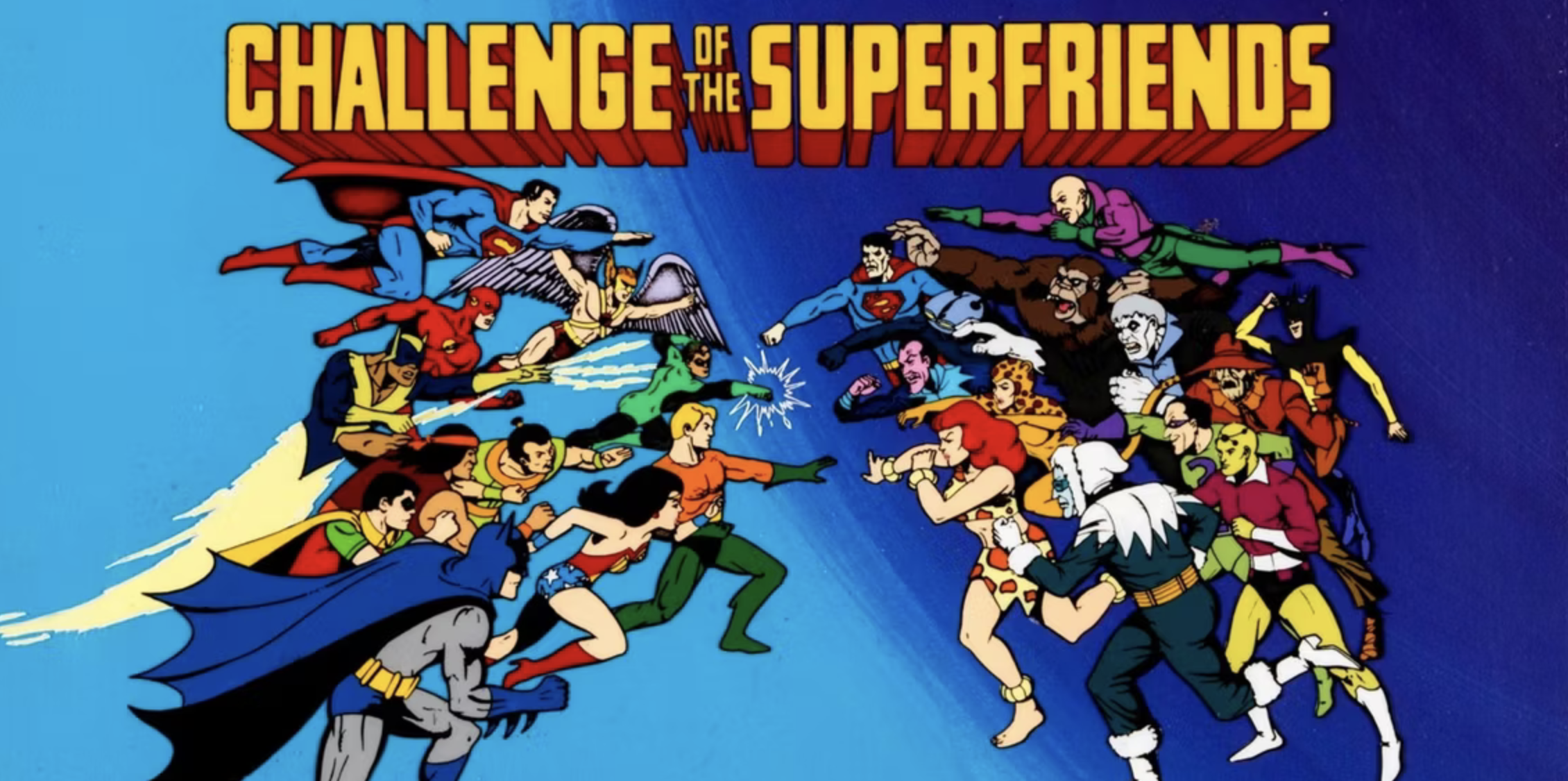
Early presentation art for the “Legion of Evil” (also called “League of Evil” for a time) showed Dr. Sivana, Sinestro, Captain Cold, Joker, Beautia Sivana, Penguin, Abra-Kadabra, Poison Ivy, Heat Wave, King Kull, Gorilla Grodd, Mr. Atom, and Cheetah.
In 1978, Hanna-Barbera had picked up the live-action rights to Captain Marvel and his villains, which is why the Sivanas, Kull, and Mr. Atom were included… as Captain Marvel was also intended to become a member of the Super Friends. One problem, though: Filmation held the animated rights to Captain Marvel and related characters. Out went the hero and his villains, as well as Joker, Penguin, Poison Ivy, and a proposed Mr. Freeze, which had been—or possibly might be—used in future Filmation New Adventures of Batman episodes on NBC. Hanna-Barbera was allowed to keep Batman villains Riddler and Scarecrow, though.
***
ABC’s Standards & Practices censorial department was nervous about Challenge because it would contain actual conflict between heroes and villains. After all, even the opening credits ended with the Darren McNeil-designed shot of the heroes and villains charging towards each other about to fight. So the stories were often softened just a bit. The villains could still have plans to conquer the world, or destroy things, but they had to be caught by the heroes for punishment.
Hanna-Barbera’s team didn’t always follow that rule, and even if the villains were caught at the end of one episode—instead of escaping at the last moment—the next episode would find them back plotting villainy in their swampy Hall of Doom, with no mention of incarceration of punishment.
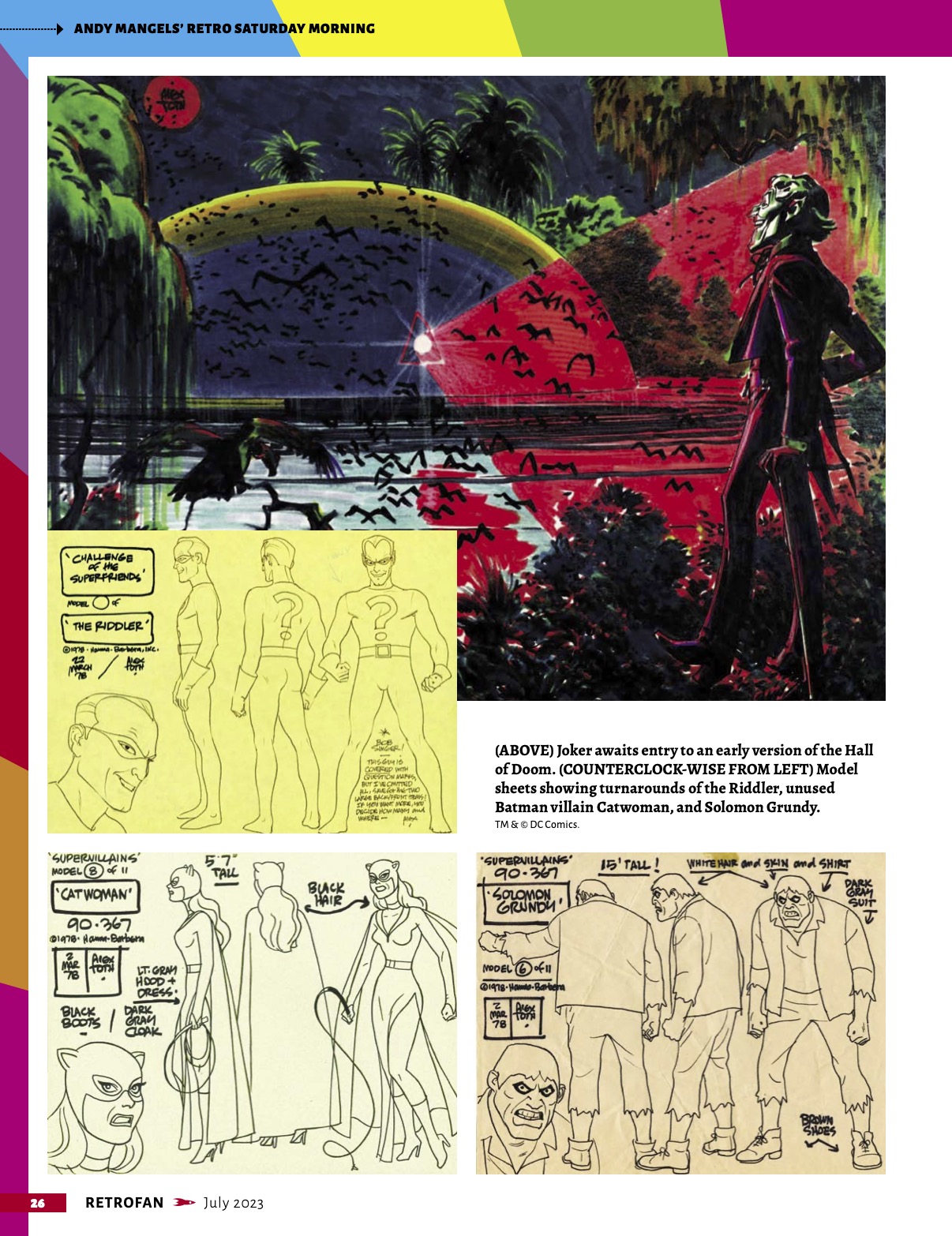
One planned episode in particular caught Standards & Practice’s notes: “History of Doom,” the season’s final episode produced, in which the villains wanted to destroy the world. S&P wrote that “destroying the world” was an imitable act, which was bad for young viewers who might want to copy it. When Hanna- Barbera pushed back that nobody watching the show could actually single-handedly destroy the world, ABC relented.
Several of the Challenge episodes dove deep into DC Comics lore. In “Trial of the Super Friends,” the villains stole Wonder Woman’s lasso, Green Lantern’s power ring, and Batman and Robin’s utility belts before putting the heroes on trial and making them fight robot doubles. In “Secret Origins of the Super Friends,” Lex Luthor and the Legion of Doom members travel back in time to stop Superman, Wonder Woman, and Green Lantern from ever existing. Although Superman’s origin had been seen before, this was the first time for animation that either Wonder Woman or Green Lantern’s stories had been featured.
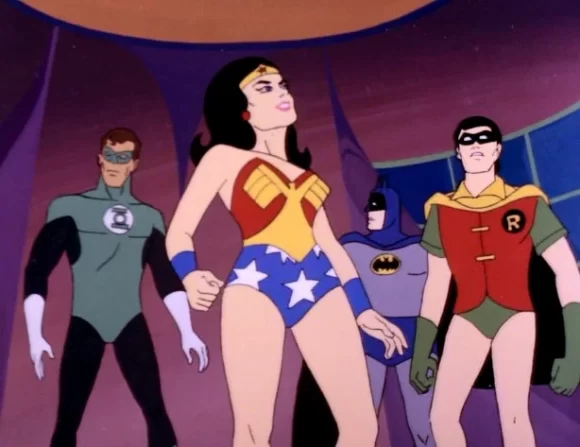
“Trial of the Super Friends”
Another episode, “Super Friends: Rest in Peace,” opened with the death of Batman, and continued with more shocking deaths, including the demise of Wonder Woman and Superman. The aforementioned “History of Doom” included the origins of Lex Luthor and Giganta. All of them were remarkably true to their comic-book roots, and “Super Friends: Rest in Peace” even featured Wonder Woman doing a kind of “Wonder Spin,” which was clearly a nod to the popular live-action Wonder Woman series starring the luminous Lynda Carter.
***
Challenge of the SuperFriends is by far most of fandom’s favorite version of the long-running series, for good reason: The stories hew most closely to their comic-book origins. Hanna-Barbera learned some lessons from this, and as Super Friends evolved, changes were made… but that’s a story for our next two issues!
For those who want a real deep dive into the minutiae of each Super Friends episode, I highly recommend the thick, two-volume The Ultimate Super Friends Companion by Will Rogers with Billie Rae Bates. The pair are available on Amazon.
—
This excerpt only scratches the surface; there’s tons more in the issue, so I highly recommend you pick it up. RetroFan #27 is available now at comics shops, magazine sellers and directly through publisher TwoMorrows. (Click here to order.)
Also, make sure you check out The World’s Greatest Super Friends Podcast, hosted by John S. Drew and yours truly. Click here.
—
MORE
— Pour Yourself Some Cereal and Dig This Groovy SUPER FRIENDS Art. Click here.
— 13 Lovable SUPER FRIENDS Covers. Click here.

June 3, 2023
New Adventures of Batman aired on CBS??? correct , the article states NBC (which did air the Animated Shazam , and Plastic Man , for that matter)
June 3, 2023
New Adventures of Batman did originally air on CBS. However, NBC aired the show in reruns as part of a block of Filmation cartoon reruns in 1980.
June 5, 2023
Fixed!
June 5, 2023
Fixed!
June 3, 2023
I always loved the challenge of the superfriends and still do to this day. The story telling was better than other feel good versions of the DC heroes and the and the super friends rest in peace is still a memorable one to this day.
June 4, 2023
They had the entire series on HBOMax. The last two seasons are painful to watch. LOL. (For a short time Adam West stepped in to voice Batman.)
June 4, 2023
It’s also not true that The Riddler and Scarecrow never made it into the series.
June 5, 2023
Yes. Tweaked.
June 4, 2023
* ERROR: If that time-travel episode kept Superman from ever existing then Bizarro should’ve also not existed! ☺
June 6, 2023
True enough; guess he was a time remnant from history being changed but not quite settling down. Kind of like Supergirl’s death in COIE being mourned for a few months post-Crisis, and then the new timeline meant she’d never existed in the new version of Earth.
June 4, 2023
I thought the last two seasons were among the best. I think folks tend to forget that at the time they were made with a younger audience in mind and as the article notes, under some restrictions by the network. They may seem simplistic by adult standards, but could be pretty exciting (though not always) to younger viewers.